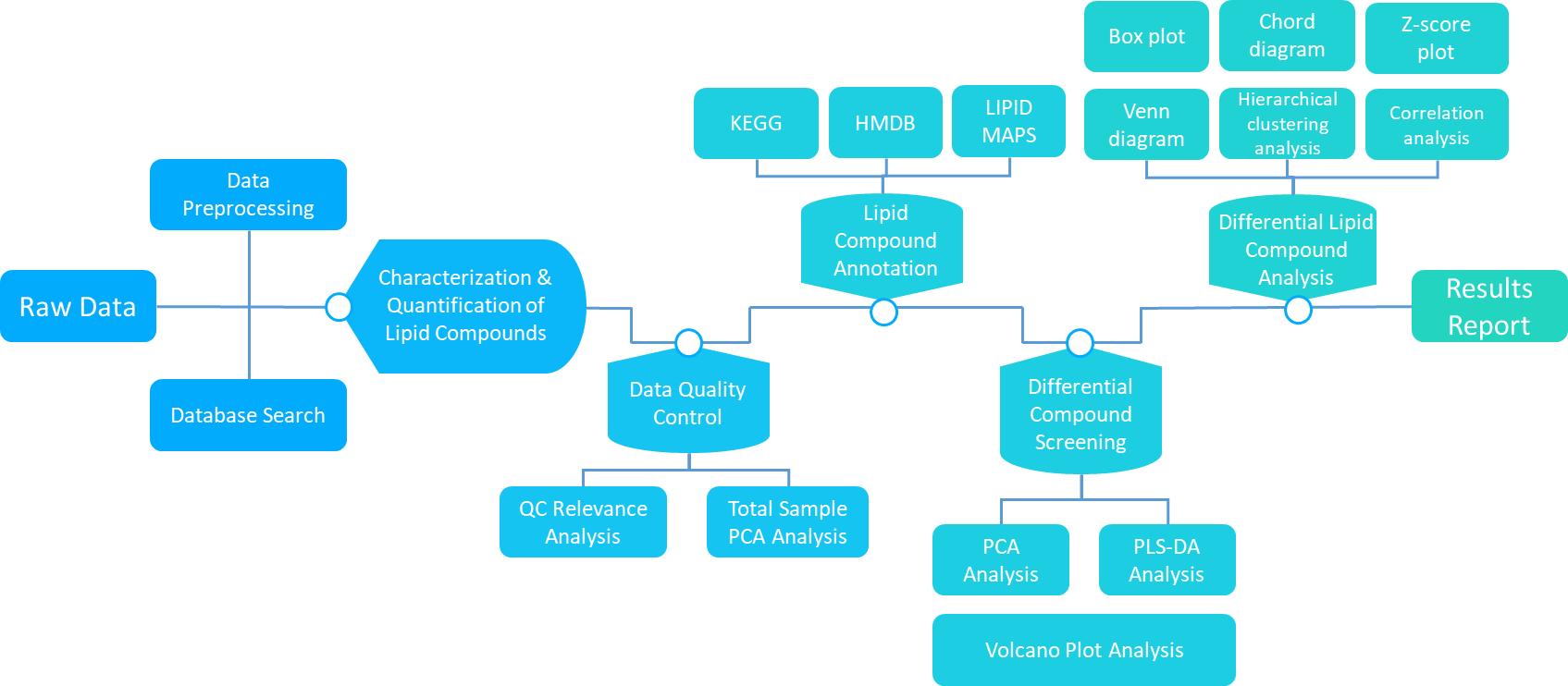Targeted Quantitative SCFA Analysis
Accurate quantification of key SCFAs, including acetate, propionate, and butyrate, in biological samples such as plasma, serum, feces, and tissue.
Our services have earned the trust of companies, schools, and organizations globally, and we remain dedicated to maintaining that trust.
Short Chain Fatty Acids (SCFAs) are saturated aliphatic monocarboxylic acids with fewer than six carbon atoms, primarily produced through microbial fermentation of dietary fibers in the gut. SCFAs play essential roles in host metabolism, immune modulation, and gut health. Common SCFAs include acetate, propionate, and butyrate, which influence energy homeostasis, inflammation, and microbial balance. Their precise quantification is critical in research fields such as nutrition, microbiome studies, and metabolic health.

Targeted Quantitative SCFA Analysis
Accurate quantification of key SCFAs, including acetate, propionate, and butyrate, in biological samples such as plasma, serum, feces, and tissue.

Lipidomics Profiling
Comprehensive lipidomics analysis of SCFAs and related metabolites, enabling detailed insight into lipid metabolism and related pathways.

SCFA Metabolic Pathway Analysis
Identification of SCFA-related metabolic pathways to explore their biological functions in metabolic and immune processes.

Microbiome-SCFA Interaction Studies
Investigating the relationship between gut microbiota composition and SCFA production.

Stable Isotope Tracing Analysis
Advanced isotope labeling techniques to track SCFA metabolic flux, providing in-depth insights into metabolic dynamics and pathway activity.

Customized SCFA Analysis Solutions
Flexible and tailored analysis services designed to meet specific research goals, including high-throughput screening, specialized sample processing, and customized reporting.
| SCFA Name | Molecular Formula | Related Metabolites | Metabolic Pathways |
|---|---|---|---|
| Acetate | C₂H₄O₂ | Acetyl-CoA, Ethanol, Formate | Acetate Pathway, TCA Cycle |
| Propionate | C₃H₆O₂ | Propionyl-CoA, Succinyl-CoA | Propionate Metabolism, Gluconeogenesis |
| Butyrate | C₄H₈O₂ | Butyryl-CoA, Crotonate | Butyrate Pathway, Fatty Acid Oxidation |
| Valerate | C₅H₁₀O₂ | Valeryl-CoA, Isovalerate | Fatty Acid Metabolism |
| Caproate | C₆H₁₂O₂ | Caproyl-CoA, Hexanoic Acid | Fatty Acid β-Oxidation |
| SCFA Name | Molecular Formula | Related Metabolites | Metabolic Pathways |
|---|---|---|---|
| Isobutyrate | C₄H₈O₂ | Isobutyryl-CoA, Methylmalonate | Branched-Chain Amino Acid Metabolism |
| Isovalerate | C₅H₁₀O₂ | Isovaleryl-CoA, 3-Hydroxyisovalerate | Leucine Metabolism, Valine Degradation |
| 2-Methylbutyrate | C₅H₁₀O₂ | 2-Methylbutyryl-CoA, Succinyl-CoA | Isoleucine Metabolism, Fatty Acid Synthesis |
| SCFA Name | Molecular Formula | Related Metabolites | Metabolic Pathways |
|---|---|---|---|
| 3-Hydroxybutyrate | C₄H₈O₃ | Acetoacetate, β-Hydroxybutyryl-CoA | Ketogenesis, Fatty Acid Oxidation |
| 4-Hydroxybutyrate | C₄H₈O₃ | Succinic Semialdehyde, GABA | GABA Shunt, Succinic Acid Pathway |
| Acetoacetate | C₄H₆O₃ | Acetone, 3-Hydroxybutyrate | Ketogenesis, Fatty Acid Degradation |
| Method | Detector/Platform | Sensitivity (LOD) | Sample Type | Derivatization Required? | Strengths | Limitations | Applications |
|---|---|---|---|---|---|---|---|
| GC-FID | Flame Ionization Detector | 0.1–1.0 µM 8 | Feces, serum, plasma | Yes (for low conc.) | Cost-effective; High reproducibility for volatile SCFAs | Poor resolution for isomers; Limited sensitivity for polar SCFAs | Routine QC in fermentation, biogas monitoring |
| GC-MS | Quadrupole MS | 0.05–0.5 µM 8 | Feces, colonic content | Yes | High specificity; Identifies branched-chain SCFAs | Requires derivatization; Matrix interference in complex samples | Research on microbiota metabolites |
| LC-MS/MS | Triple Quadrupole MS | 0.01–0.1 µM | Plasma, serum, tissues | Optional (O-BHA derivatization improves sensitivity) | High sensitivity; Quantifies non-volatile SCFAs (e.g., lactate, succinate) | Matrix effects require SIL-IS | Preclinical studies, pharmacokinetics |
| UHPLC-QE-Orbitrap | High-Resolution MS | 0.001–0.01 µM | Serum, complex matrices | No | Ultra-high resolution; Detects trace isomers (e.g., isobutyrate vs. butyrate) | Data complexity requires expertise | Aging/metabolic disease research |
| Static Headspace-GC-FID | FID with SHS | 0.1–10 ppm | Pharmaceutical residues, food | No | Minimal sample prep; Avoids solvent interference | Limited to volatile SCFAs; Lower sensitivity | Residual solvent analysis in drugs |
Sample Complexity:
Throughput vs. Cost:
Isomer Differentiation:
Results we provide:
Data analysis:
Results provided:
Data insights:
Results provided:
Data insights:
 Workflow of Lipidome Data Analysis
Workflow of Lipidome Data Analysis
Explore our Lipidomics Solutions brochure to learn more about our comprehensive lipidomics analysis platform.


Metabolic Pathway Analysis
Identify SCFA-related biochemical pathways in various biological systems.

Biotechnology and Bioenergy
Study SCFA production in microbial fermentation for industrial applications.

Nutritional Studies
Assess dietary effects on SCFA metabolism and energy utilization.

Agricultural and Animal Science
Analyze SCFAs in soil, feed, and livestock metabolism.

Food and Beverage Industry
Optimize fermentation processes and assess SCFA composition in fermented products.

Environmental Monitoring
Detect SCFAs in wastewater, soil, and fermentation systems.
| Sample Type | Minimum Volume/Amount Required | Storage Conditions | Notes |
|---|---|---|---|
| Plasma/Serum | 50-100 µL | -80°C, avoid freeze-thaw cycles | Collect in EDTA or heparin tubes, centrifuge, and store supernatant. |
| Feces | 50-100 mg | -80°C | Freeze immediately after collection, avoid prolonged exposure to air. |
| Urine | 500 µL | -80°C | Preferably first-morning urine, centrifuge if necessary. |
| Tissue | 50 mg | -80°C | Snap freeze in liquid nitrogen, store in airtight tubes. |
| Cell Culture Media | 500 µL | -80°C | Collect supernatant, filter to remove debris, and freeze. |
| Fermentation Broth | 1 mL | -80°C | Centrifuge, remove particulates, and store supernatant. |
Should samples be processed immediately after collection? How to prevent SCFA degradation?
SCFAs are volatile and susceptible to microbial metabolism, so prompt processing is essential.
How do SCFA extraction methods differ for various sample types (feces, serum, tissue)?
Why is derivatization necessary? What are the advantages of different derivatization reagents?
SCFAs have high polarity and volatility, making direct detection challenging due to peak overlapping and low sensitivity.
Which method is better for SCFA detection: GC-MS or HPLC?
How to assess the reliability of SCFA analysis results?
Why might low-abundance SCFAs (e.g., isovalerate) not be detected?
How can SCFA results be interpreted alongside gut microbiota data?
How to choose internal standards? What are common issues?
Recommended Internal Standards: Butyrate-d4, 2-methylpentanoic acid, selected based on similar physicochemical properties to SCFAs.
Common Issues:
What key information should be included in the data report?

References
Services:
Resource:
Platform:
Online Inquiry
CONTACT US